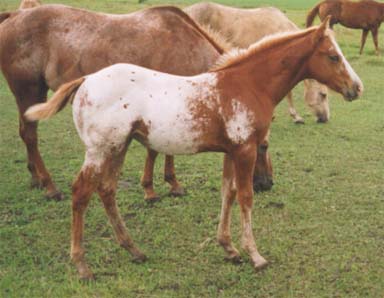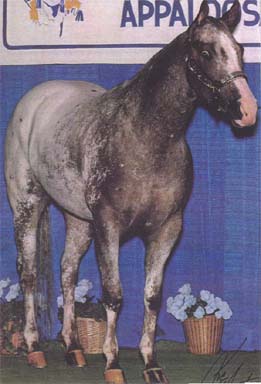
|
The Appaloosa
| ||

Look around you. Chances are, you'll see an Appaloosa wherever you go. That is because the word is out about this beautiful horse. Not only are Appaloosas different from any other breed, each Appaloosa is different from any other. It is a handprint of color, what Appaloosa enthusiasts call "the chrome" that is so much a part of the breed' mystique.
People who own Appaloosas appreciate this difference. But there is more to the Appaloosa than meets the eye. Breeders have worked hard to preserve the Appaloosa's special characterisitics. Further, by selecting for top performance and conformation traiters, they have developed a truly extraodinary horse. Today's Appaloosas compete in the upperechelons of virtually every sprot imaginalbe-from cutting to combined training, reining to racing. And while the Appaloosa more than lives up to the athletic demands of today's serious competitors, no other breed can duplicate the qualities and characterisitcs that make the Appaloosa unique. The Appaloosa is the horse Nature destined to be different.

The Appaloosa's colorful ancestry can be traced back to earliest recorded time, bit it is in the American melting pot that the spotted horse established itself as a true breed. The Nez Perce Indians of the inland Northwest deserve much of the credit for the Appaloosa horse we have today. They were renowned horsemen. Unlike other tribes, the Nez Perce were the only Native Americans known to selectively breed their horses. The Nez perce desired only the strongest, fastest, and most sure-footed of mounts. They used only the best animals to buld their herds. Within their numbers, arose a population of horses so distinctive as to inspire early American explorer Meriweather Lewis to describe them in his journal entry, dated February 15, 1806: "there horses appear to be of an excellent race; they are lofty, eligantly (sic) form, active and durable...Some of those horses are pided with large spots of white irregularly scattered and intermixed with black, brown, bey (sic) or some other dark color.."
However, the influx of white settlers to the Northwest changed the Nez Perce's destiny and nearly destroyed the legacy of their horse-breeding efforts. When the Nez Perce rebelled againts the treaties being imposed upon them, war ensued. The Appaloosa helped the non-treaty Nez Perce elude the U.S. Cavalry for several months as they traversed over 1,300 miles of rugged, mountainous terrain. When Chief Joseph finally surrendeder in Montana, the Nez Perce were forceed to relinquish their horses. The Army quickly disbanded them. Soon the characterisitics so prized by the Indians were being lost or severly diluted doe to indiscriminate breeding. The Appaloosa nearly dissappeared following the Nez Perce War of 1877.
It was Claude Thompson, a wheat farmer from Moro, Oregan, who realized the importance of preserving the spotted horse breed. He established the Appaloosa Horse Club in 1938 to promote and restore the Appaloosa's positiion in the horse world. In doing so, the colorful breed began its return from the brink of extinction.
Although the Nez Perce never called their spotted horses "Appaloosas," the breed's name comes for "the Palouse," the region of eastern Washington and northern Idaho where the horses were known to be plentiful. White settlers first described teh colorful native mountst as "a Palouse horse," which was soon slurred to "Appalousey." Appaloosa was the name officially adopted when the Appaloosa Horse Club was formed in 1938.
Those early years werea a period of slow growth for the fledgling registry. The country was immersed in World War II. After the war ended, that changed. In 1947, Claude Thompson appointed 23 year old Gearge Hatley as Executive Secretary. Hatley took the shoebox containg the Appaloosa Horse Club's records to Moscow, Idaho. There were 200 registered horses and 100 ApHC members. The ApHC quickly outgrew its shoebox.
Today the Appaloosa Horse Club is a major international breed registry. Well over a half million Appaloosas have been entered into the rolls. The Appaloosa Horse Club has nearly 30,000 members who add more than 10,000 horses to the Registry each year.

When you drive by a pasture full of horses, i you like o play "identify that breed," the Appaloosa will likely be your winning point. for most people, the Appaloosa is the easiest horse to spot due to its distinctive coat patterns. What some people fail to realize, however, is that Appaloosas have other identifiable characteristics as well. That's more, Appaloosa coat patterns come in infinite variety-from no spots at all, to more sprots than you can count. Some Appaloosas even have spots on their spots! Certain Appaloosas have white "blankets," which look like a covering of fresh fallen snow over their backs, loins, or hips. Som Appaloosas are described as "leapords," with Dalmatian-like spots. There are Appaloosa roans, and any number of spotting combinations.
The variety and unpredicatbility of Appaloosa patterns is especially intriguing to breeders. However, Appaloosa patterns should not be confused with the overo and tobiano markings of Pintos or Paints. Paint markings tend to be larger and of a different shape and placement than those of the Appaloosa.

There are also three other visible traits that contribute to the Appaloos'a unique appearance. One is the irregularly pigmented or "mottled" skin which is most apparent around the horse's muzzle, eyes and genitals. Also, many Appaloosas have a distinctly human-looking eye due to the white sclera surrounding the iris, the dark-colored center portion of the eye. Also, you may notice that many Appaloosas have vertical stripes on their hooves in the absence of white leg markings. An Appaloosa need only have mottled skin and one other visible characteristic for "regular" registration status. Above is a picture of the characteristics.
However, not every Appaloosa is blessed with easily identifible traits. Recognizing this quirk of nature, the Appaloosa Horse Club also accepts solid-colored horses for registration. Non-patterened Appaloosas can be used for breeding purposes, however in order to be raced or shown, solid-colored horses must also undergo parentage verification and inspection.
Appaloosas are world renowned for their versatility. One reason is that Appaloosa owners have the luxuryof breeding for specific comformation and performance traits-wheter selecting for an agile western stock horse or grand strided dressage horse. Breeders may mate Appaloosa to Appaloosa, or "crossbreed" to registered American Quarter Horses, Thoroughbreds, and Arabians.





If you know of any diseases that affect primarily Appaloosas, please e-mail me. I want to add a section about the diseases that affect the different breeds. I will appreciate any information you can give. Thank you. Denise Larson